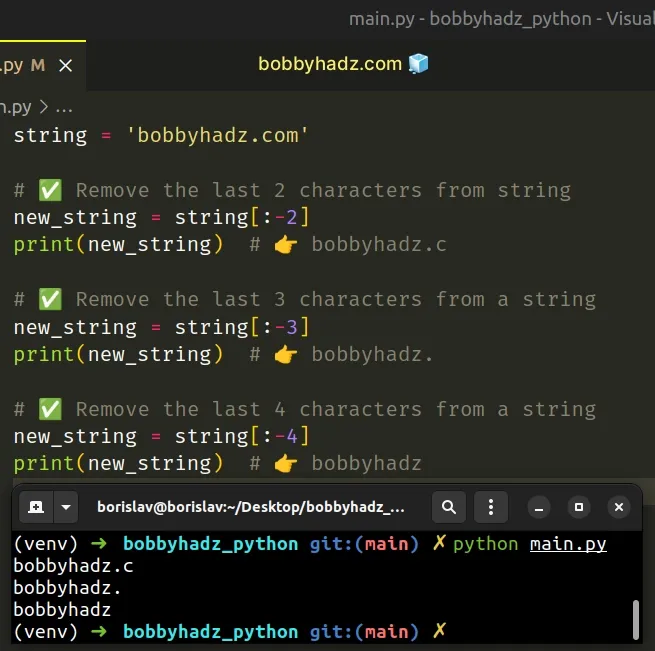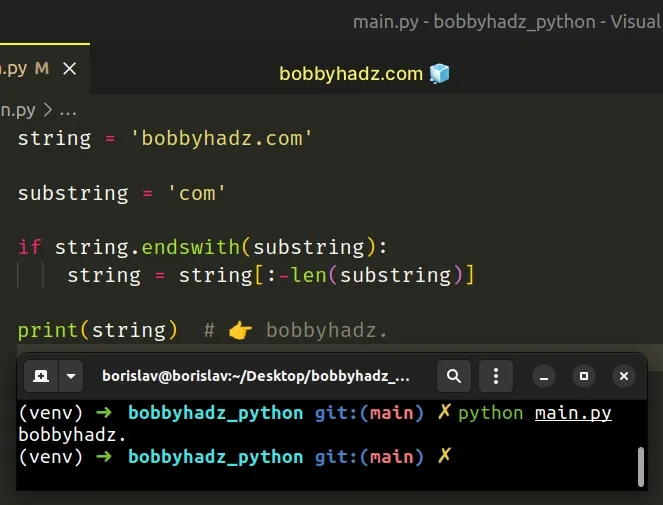Remove the last N characters from a String in Python
Last updated: Apr 10, 2024
Reading time·4 min

# Table of Contents
- Remove the last N characters from a String in Python
- Remove the last N characters if they are equal to a certain value
- Remove the last N characters from a String using positive slicing
- Remove the last N characters from a String using a for loop
# Remove the last N characters from a String in Python
Use negative string slicing to remove the last N characters from a string,
e.g. new_string = string[:-N].
The slice will remove the last N characters from the string by returning a copy of the string that goes up to, but not including the last N characters.
string = 'bobbyhadz.com' # ✅ Remove the last 2 characters from string new_string = string[:-2] print(new_string) # 👉️ bobbyhadz.c # ✅ Remove the last 3 characters from a string new_string = string[:-3] print(new_string) # 👉️ bobbyhadz. # ✅ Remove the last 4 characters from a string new_string = string[:-4] print(new_string) # 👉️ bobbyhadz

We used string slicing to remove the last N characters from a string.
The syntax for string slicing
is my_str[start:stop:step].
start index is inclusive, whereas the stop index is exclusive (up to, but not including).Python indexes are zero-based, so the first character in a string has an index
of 0, and the last character has an index of -1 or len(my_str) - 1.
Negative indices can be used to count backward, e.g. my_string[-1] returns the
last character in the string and my_string[-2] returns the second to last
item.
The slice string[:-2] starts at index 0 and goes up to, but not including
the second to last character in the string.
string = 'bobbyhadz.com' new_string = string[:-2] print(new_string) # 👉️ bobbyhadz.c
In other words, the slice returns a new string that doesn't contain the last 2 characters of the original string.
If you don't need to keep the original variable around, reassign it rather than declaring a new variable.
string = 'bobbyhadz.com' string = string[:-3] print(string) # 👉️ bobbyhadz.
The slice string[:-3] starts and index 0 and goes up to, but not including
the last 3 characters in the string.
# Remove the last N characters if they are equal to a certain value
If you only want to remove the last N characters from a string if they are equal
to a certain value, use the str.endswith() method.
string = 'bobbyhadz.com' substring = 'com' if string.endswith(substring): string = string[:-len(substring)] print(string) # 👉️ bobbyhadz.

The example only removes the last 3 characters from the string if the string ends with the specified characters.
The
str.endswith()
method returns True if the string ends with the provided suffix, otherwise the
method returns False.
Alternatively, you can use positive string slicing.
# Remove the last N characters from a String using positive slicing
This is a three-step process:
- Get the string's length and subtract N.
- Get a slice of the string starting at index
0and going up to the string's length minusN. - The new string won't contain the last N characters.
string = 'bobbyhadz.com' new_string = string[:len(string)-2] print(new_string) # 👉️ bobbyhadz.c new_string = string[:len(string)-3] print(new_string) # 👉️ bobbyhadz. new_string = string[:len(string)-4] print(new_string) # 👉️ bobbyhadz

We used the len() function to get the length of the string.
The len() function returns the length (the number of items) of an object.
print(len('ab')) # 👉️ 2 print(len('abc')) # 👉️ 3
A string's length is always going to be last_index + 1 because indices are
zero-based in Python.
For example, if a string has a length of 10, the last index in the string is
9.
stop index of 9 (or len(string) - 1), you would remove the last character from the string because stop indices are exclusive (up to but not including).Similarly, if you specify a stop index of 8 (or len(string) - 2), you
would remove the last 2 characters from the string.
Alternatively, you can use a for loop.
# Remove the last N characters from a String using a for loop
This is a three-step process:
- Use a
forloop to iterate over the string withenumerate(). - Check if the current index is less than the length of the string - N.
- If the condition is met, append the character to a new string.
string = 'bobbyhadz.com' new_string = '' n = 3 for index, char in enumerate(string): if index < len(string) - n: new_string += char print(new_string) # 👉️ bobbyhadz.
We used the enumerate() function to get access to the index of the current
iteration.
string = 'abc' for index, char in enumerate(string): print(char, index) # 👉️ a 0, b 1, c 2
The enumerate() function takes an iterable and returns an enumerate object containing tuples where the first element is the index and the second is the corresponding item.
On each iteration, we check if the current index is less than the string's length minus N.
This is very similar to the positive slicing approach from the previous example.
If the condition is met, we add the current character to a new string.
The += operator is a shorthand for new_string = new_string + char.
Which approach you pick is a matter of personal preference. I'd use the negative string slicing approach as I find it quite direct and readable.
I've also written an article on how to remove the first N characters from a string.
# Additional Resources
You can learn more about the related topics by checking out the following tutorials:
- Remove the last comma from a String in Python
- Remove first occurrence of character from String in Python
- Remove the HTML tags from a String in Python
- Remove First and Last Characters from a String in Python
- Remove Newline characters from a List or a String in Python
- Remove non-alphanumeric characters from a Python string
- Remove non-ASCII characters from a string in Python
- Remove the non utf-8 characters from a String in Python

